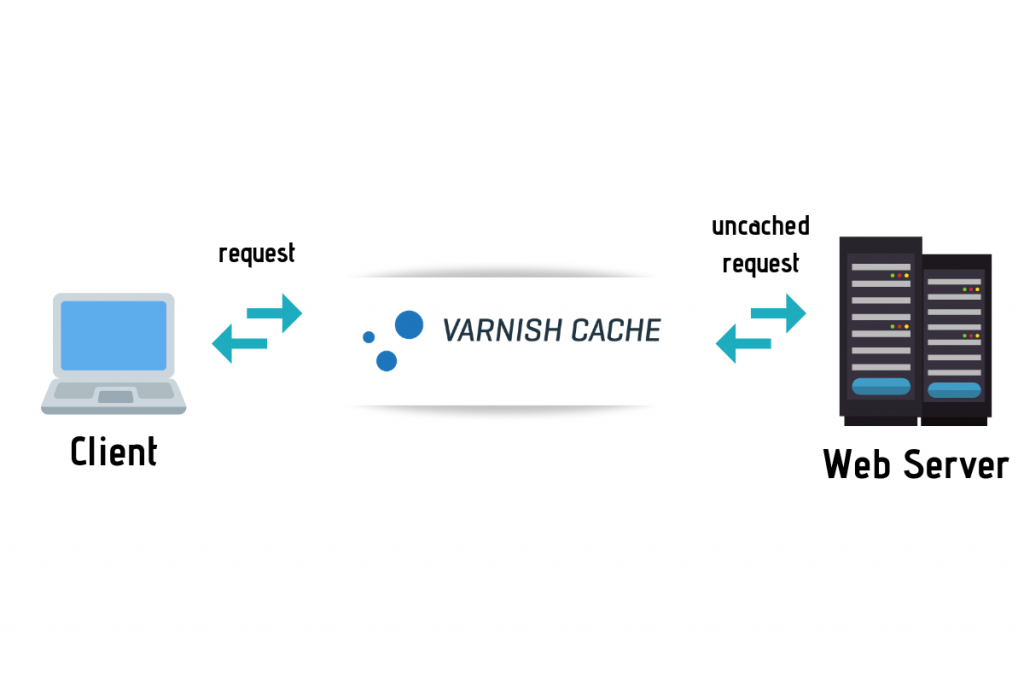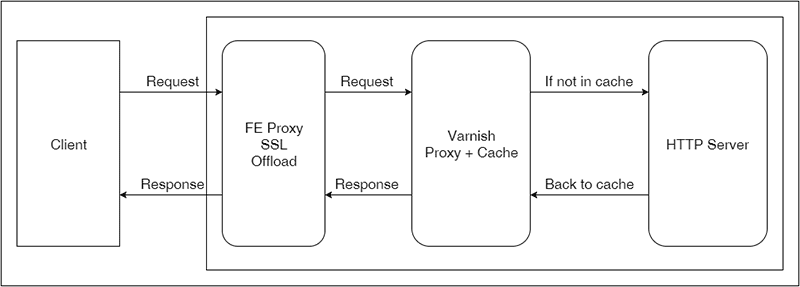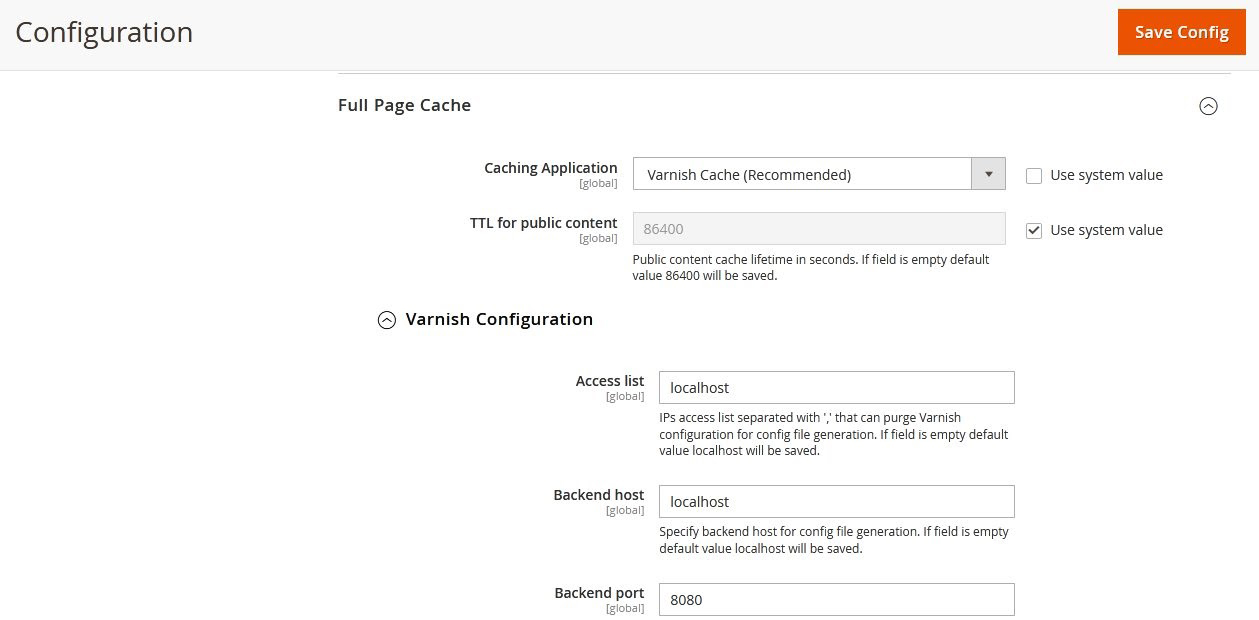Feb 11, 2021 | 05 min read
2. What is Magento Cache? How does it work?
The cache is a component that stores data, so future requests for that data can be served faster. It’s a small space inside the system hardware or software used to store frequently used data. The system can get the stored data and display it instantly without calculating again, which results in better performance. In Magento 2 there are various types of cache you can use. For example, FPC, Redis or Memcached, Varnish cache. Each of which has a different use a full-page cache module stores the entire HTML code of a generated page in the cache storage. As storage, Magento by default uses File cache or Varnish cache.
Varnish cache is ultra-fast and recommended for any size store, but it requires additional steps to install and configure.
Redis is one of the most popular caching solutions. It keeps data in the server memory (RAM). In some cases, the cached data can also partially be saved on the disk.
Cache is useful for fast data delivery. When your store visitor opens any page in the browser, his or her request goes to the Magento 2 cache system:
- If the requested page is inside cache storage, it is quickly returned to the visitor. The speed of such an operation is very high.
- If the requested page is not present in the cache storage yet, Magento will generate this page, add it to the cache storage, and return it to a customer. The speed of such an operation is much lower.
The cached data is stored in files on an disk. You can find them on a server in the magento_installation_folder/var/cache/ and magento_installation_folder/var/page_cache/ folders.
3. Why is Page Cache so important?
The correct work of the cache system directly affects the store speed. And the speed influences the store performance in Google search results and conversion of store visitors into buyers.
All pages on the following list cannot be cached by default:
- Login/registration/forgot password pages
- Customer account pages
- Search results pages
- Cart page
- Checkout and also as part of other rarely visited pages
- If the requested page is inside cache storage, it is quickly returned to the visitor. The speed of such an operation is very high.
- If the requested page is not present in the cache storage yet, Magento will generate this page, add it to the cache storage, and return it to a customer. The speed of such an operation is much lower.
However, the below pages are cacheable:
- Home page
- CMS pages
- Products list (category)
- Product details
4. Magento 2 Cache Solutions
Redis
Redis is one of the most popular caching management systems used for not only Magento 2 but all kinds of websites. It keeps data in the server memory (RAM) for the best performance.
Pros:
- RAM is much faster than disk drives.
- RAM is optimized for fast access data.
Cons:
- Redis can consume a lot of RAM. Unlike disk drives, RAM just has a small capacity.
- Optimization can be tricky.
Varnish Cache
Varnish Cache is really fast. Use Varnish Cache for a fast loading website.
Varnish Cache is one of the most reliable caching solutions in Magento. This is an efficient solution to increase not only your website speed but also your server performance. Magento stores have to handle huge volumes of traffic. Multiple visitors click on the website pages at the same time and the visit requests are directly sent to the back-end or server. It is the server’s job to process the requests and send them back to the users who are then able to see the page they have requested.
The varnish is a proxy server. It is useful to deliver content fast. When a visitor requests your site repetitively, then this request will not be sent to Magento, it’s delivered from the cache. Varnish checks if visitors request for Home page, Checkout, without firing a MySQL query, or without hitting any PHP code it delivers content from the cache.
Magento 2 is a very strong platform as it supports various features including varnish cache. When you are using the varnish cache server, you can ensure that the requests are received by this accelerator rather than a web server. There are lots of benefits to using Varnish cache, it reduces the load of the backend, as it delivers the content from the cache server. If you desire to grab these benefits, you can immediately perform Magento 2 varnish cache setup.
The page loading times are likely to increase and the site may even crash because Magento is equipped to handle only a limited number of visits at a time. Such circumstances translate into problems for the e-commerce retailer as these can lead to loss of conversions, customers, and even reputation.
Benefits of using Varnish cache
- Reduce the Load of SQL, PHP as because delivered from the proxy server.
- Reduce the load of the backend.
- Response time is improved.
- The cache server is faster than the origin server when delivering objects
- The system will serve many requests
- Time To First Byte (TTFB) decreases because the processing time for the backend server database is lower
- Enhanced speed and performance.
- Saving in hosting cost.
- Improved end-user experience.
- Boost conversion rate.
- Improved SEO value.
How Does Varnish Cache Work?
Varnish Cache is a web server accelerator that works as a reverse proxy server to enhance the website speed. It enables lightning-fast content delivery by means of caching the copy of web pages when the user visits them for the first time. Subsequently, the future requests for these pages are served by the cache. This reduces the backend server load even while the Magento store handles an unlimited number of visitors simultaneously. The cached requests are then stored in the memory. From this moment on, retrieving and delivering them to clients will be much faster.
Varnish uses a language called VCL (Varnish Configuration Language). Through this language and its alterations, you can handle each request differently. For example, you can choose to forward specific requests to a particular backend, or you can ask Varnish to act differently depending on the properties of the inbound request or its output.
User request will be sent to the server if it’s not in cache and respond to the user. This response will be saved in the Cache system. When a user requests the same thing in future access then it will be delivered from the cache. So using this cache behavior site loads content fast and delivers it to the user.
How to configure Varnish Cache in Magento2?
To configure Magento to use Varnish log in to the Magento Admin:
- Go to Stores > Configuration > Advanced > System > Full Page Cache.
- From the Caching Application list, click Varnish Caching.
- Enter a value in the TTL for the public content field.
- Expand Varnish Configuration and enter the specific information about your Varnish configuration.
- Save Configuration.
- To export a Varnish configuration file from the Admin panel:
- Click one of the export buttons to create a varnish.vcl you can use with Varnish.
- For example, if you have Varnish 4, click Export VCL for Varnish 4
5. Conclusion:
If you want to boost the speed of the store page, Magento 2 cache solution is very helpful to improve the site speed. It ensures that the loading speed of your site is increased. Once the speed of the website gets increased then there will be a good conversion, sales on your website. If any queries related to this blog or if you’re facing any challenges during Varnish Setup feel free to Contact Us.







